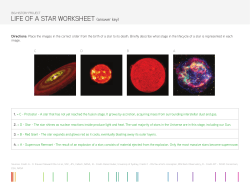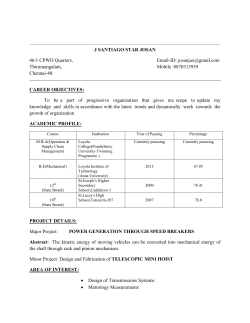
On V/R Variability of Hα - Emission in ζ Tauri
On V/R Variability of Hα - Emission in ζ Tauri (published in Be Star Newsletter Vol. 36) At many Be-stars the Hα-emission line profiles have occasionally the form of asymmetrical double peaks. For the characterisation of asymmetry the maximum intensity of the shortest wavelength peak of the line (in units of the intensity of the neighbouring continuum) with V (violet) is designated, and those of the longest wavelength peak with R (red). The direction of asymmetry is described by the quotient of the intensities V/R. This paper reports the results of spectroscopic monitoring of the Be star ζ Tau. Specifically, it describes periodic changes in the V/R relationship and the reversal of that relationship from > 1 to < 1. ζ Tau is one of the best known Be stars in the northern sky. Its literature covers all aspects of the object including its spectral characteristics. Most publications address questions about the equatorial gas disk which the central star hurls into orbit due to its high rotation speed. The kinetics of gas motion in the disk and the disk's density structure and stability are subjects of ongoing research. Okazaki [1] addressed these questions with a new model based on global oscillations in cool, non-self-gravitating, geometrical disks that are susceptible to radial disturbances. His approach depended on variations in the V/R relationship. A so-called "onearmed oscillation" in such a disk can extend throughout its structure as wavy density disturbances. Adding to the difficulty of understanding ζ Tau is irregular mass transfer from the star's photosphere into the surrounding gas envelope. This is inferred from emission lines in the disk that sometimes have relatively constant intensities and radial velocities and at other times show cyclical change. For example, Mon [2] found quasi-periodic behavior in the V/R relationship during 1970-1986. However, the observations have gaps ranging from months to four or five years. Guo [3] observed during 1990-1994 but the rate of observation was not great enough to prove short-term periodicities in V/R. Guo et al. [4], who observed during 1974-1995, and Hanuschik et al. [5], who covered 1982-1993, provided the first evidence for intensity changes on a timescale of days and weeks. However, Miroshnichenko et al. [6] found no periodic change over weeks. Figure 1 shows my observations from November 2000 to April 2001. This regrettably short coverage resulted because my spectrograph was not available before November and ζ Tau's apparition ended in April. A sine function fit to the points indicates that the V/R relationship changed with a period of about 71 days. Miroshnichenko [7] assumed that orbital movements by interactive tidal disturbances in the disk exert an influence on V/R. Fig. 1 may be observational evidence of additional oscillation modes that could exist if this assumption is correct. Delplace [8] observed from March 1960 to September 1967 at the rate of a few observations per year. Based on these results, the time of V/R reversal is uncertain by several months ranging from December 1963 to August 1964. By sampling the object 18 times between November 2000 and November 2001, as shown in Figure 2, I observed reversal in October 2001. By April recovery of the V peak had begun. By October 16, my first observation of the new season, the V peak's progress is clear and by October 23, just seven days later, the reversal to V/R < 1 had occurred. Fig. 2 demonstrates how a high rate of observation can be helpful in determining an accurate V/R period (all spectra are taken up with the new grating spectrograph). Fig. 1: Observational evidence of additional oscillation modes ? Fig.: 2: High observation rate for determining an accurate V/R period In the season from October 2001 to January 2002, bad weather created large gaps in the coverage. It was not possible to confirm the V/R periodicity shown in Figure 1. Finally, Mon et al. [2] found that the cycle of V/R variations changed about 1982. Guo [3] observed the beginning of a new cycle that lasted about 3.5 years. It appears that V/R variations are very complicated. Durations and amplitudes of cycles change and sometimes cycles disappear only to become unexpectedly active again. Such instability makes it important to monitor ζ Tau as often as possible. References: [1] A. T. Okazaki: Long-Term V/R-Variations of Be Stars Due to Global One-Armed Oscillations of Equatorial Disks; Publ. Astron. Soc. Japan, 43 75-94, (1991) [2] M. Mon, T. Kogure, M. Suzuki, M. Singh: Spectroscopic State of the Be Star zTau in 1976-1986; Publ. Astron. Soc. Japan, 44, 73-75, (1992) [3] Y. Guo: A New V/R Cyclic Change of Ha in z Tau; Information Bulletin on Variable Stars, Konkoly Observatory Budapest, IBVS-Nr. 4112 [4] Y. Guo, L. Huang, J. Hao, H. Coa, Z. Guo, X. Guo: A spectroscopic and photometric study of the Be/shell star zTau; Astron. Astrophys. Suppl. Ser. 112, 201-211, (1995) [5] R. W. Hanuschik, W. Hummel, E. Satorius, O. Dietle, G. Thimm: Atlas of high-resolution emission and shell lines in Be stars. Line profiles and short-term variability; Astron. Astrophys. Suppl. Ser. 116, 309-358, (1996) [6] A. Miroshnichenko, K. Bjorkman, V. D. Krugov: Long-term High-resolution Spectroscopy of gCas, zTau, and pAqr; American Astronomical Society Meeting, 196, #05.03, Public. Date 05/2000 [7] A. Miroshnichenko: Private communication, Nov/2001 [8] A. M. Delplace: Instabilities in the Envelope of the Be Star z Tau; Astron. & Astrophys. 7, 68-85, (1970) Ernst Pollmann
© Copyright 2025












